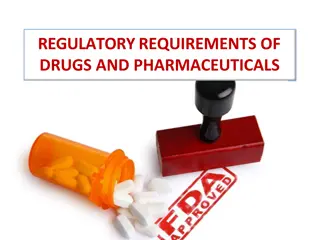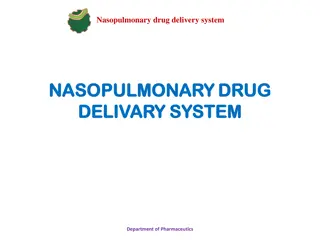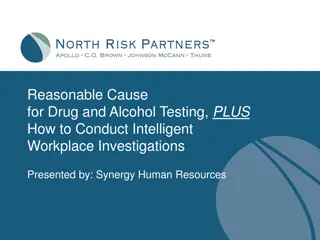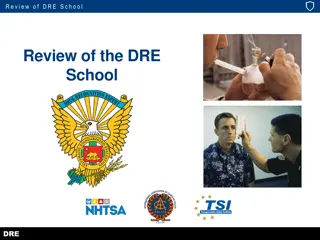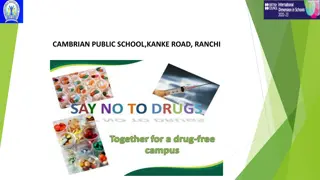Drug-Free Workplace Training Overview
This drug-free workplace training provides essential knowledge for supervisors in identifying and responding to substance misuse among employees. It covers statistics on substance use disorders, the benefits of a drug-free workplace, relevant federal laws, warning signs of substance misuse, and the role of supervisors in handling such situations. The training also emphasizes the importance of having a substance misuse policy in place to ensure a safe and productive work environment.
Download Presentation

Please find below an Image/Link to download the presentation.
The content on the website is provided AS IS for your information and personal use only. It may not be sold, licensed, or shared on other websites without obtaining consent from the author.If you encounter any issues during the download, it is possible that the publisher has removed the file from their server.
You are allowed to download the files provided on this website for personal or commercial use, subject to the condition that they are used lawfully. All files are the property of their respective owners.
The content on the website is provided AS IS for your information and personal use only. It may not be sold, licensed, or shared on other websites without obtaining consent from the author.
E N D
Presentation Transcript
Drug-Free Workplace Training
WELCOME! 2
Introduction According to data from the federal Substance Abuse and Mental Health Services Administration (SAMHSA) National Survey on Drug Use and Health: Approximately 70 percent of all adults with an alcohol or illicit drug use disorder are employed. Nearly 9 percent of all employed adults (approximately 13.6 million workers) have current alcohol or illicit drug use disorders. A relatively equal number of employed adults (approximately 13.4 million workers) report that they are in recovery or have recovered from a substance use problem. 3
Introduction (cont.) Given that the majority of people with alcohol or drug addiction are employed, it is important for you, as supervisors, to know how to identify and respond when managing employees who misuse substances. This presentation provides you with that important knowledge as well as an overview of related federal laws. 4
Agenda The benefits of a drug-free workplace. Federal laws. Warning signs of substance misuse. Your role in identifying and responding to substance misuse. Important components of our substance misuse policy. 5
The Benefits of a Drug-Free Workplace Compliance with the Drug-Free Workplace Act and other federal laws. A safer workplace for all employees and customers. Fewer employee accidents and injuries. Decreased workers compensation insurance premiums. Increased employee productivity. 6
Federal Laws Drug-Free Workplace Act. Omnibus Transportation Employee Testing Act of 1991 Americans with Disabilities Act (ADA). Family and Medical Leave Act (FMLA). National Labor Relations Act (NLRA). 7
The Drug-Free Workplace Act Under the Drug-Free Workplace Act of 1988, a drug-free workplace policy is required for: Any organization that receives a federal contract of $100,000 or more. Any organization receiving a federal grant of any size. 8
The Drug-Free Workplace Act Employers covered under the Drug-Free Workplace Act are required to: Prepare and distribute a formal drug-free workplace policy statement. Establish a drug-free awareness program. Ensure that all employees notify the employer within five calendar days if the employee is convicted of a criminal drug violation. Notify the federal contracting agency of any covered violation. Take action if an employee is convicted of a workplace drug violation. Maintain an ongoing good faith effort to meet all the requirements of the Drug- free Workplace Act. 9
Omnibus Transportation Employee Testing Act of 1991 The Omnibus Transportation Employee Testing Act requires drug and alcohol testing of all safety-sensitive transportation employees in aviation, trucking, railroads, mass transit, pipelines and other transportation industries. Any employer whose business is regulated by one of the following federal agencies and organizations is covered under the act: Federal Aviation Administration (FAA) Federal Motor Carrier Safety Administration (FMCSA) Federal Railroad Administration (FRA) Federal Transit Administration (FTA) National Highway Traffic Safety Administration (NHTSA) Pipeline and Hazardous Materials Safety Administration (PHMSA) U.S. Coast Guard 10
Omnibus Transportation Employee Testing Act of 1991 Although each of the above agencies has developed its own specific guidelines and procedures for complying with the Omnibus Transportation Employee Testing Act, the following core requirements apply to all employers and employees within the transportation industry: Employers are required to have a random drug testing program in place and must also test safety-sensitive employees for reasonable cause, immediately following an accident and before allowing an employee to return to duty following a testing violation. Employers are also required to have a program of random drug testing in place. All drug testing must be carried out by a certified laboratory listed by the Department of Health and Human Services (HHS). All drug testing conducted under the act must test for five different classes of drugs: marijuana metabolites, cocaine metabolites, amphetamines, opioid metabolites, and phencyclidine (PCP). 11
Omnibus Transportation Employee Testing Act of 1991 The Omnibus Transportation Employee Testing Act (cont.) All alcohol testing of employees must strictly adhere to DOT's policies and procedures for alcohol testing. The testing must be conducted using devices and equipment approved by DOT. All tests must be reviewed by a qualified medical review officer. Employees must be allowed to consult with this officer before the test result is reported to the employer. All employees, whether in safety-sensitive positions or not, must receive drug and alcohol awareness training and education. All supervisors must receive at least two hours of training in substance use detection, documentation, and intervention. The employer must refer any employee found to have a substance use problem to a trained substance abuse professional. This professional will be responsible for evaluating the employee's treatment needs and assessing the employee's ability to return to work. 12
Americans with Disabilities Act The Americans with Disabilities Act (ADA) prohibits the discrimination of employees with disabilities and requires employers to reasonably accommodate an individual with a disability in the workplace. Under the ADA, alcohol use disorder may be a covered disability; however, an employee with alcohol use disorder may be held to the same standards as other employees, even if unsatisfactory performance is caused by the addiction to alcohol. The ADA does not cover individuals who are currently using illegal drugs. 13
Family and Medical Leave Act Absences due to substance use treatment may be covered under the Family and Medical Leave Act (FMLA) if the substance use constitutes a serious health condition that includes either of the following: Any period of incapacity or treatment connected to inpatient care such as substance use treatment or hospitalization. Continuing treatment by a health care provider, which includes any period of incapacity (i.e., inability to work) due to a health condition lasting more than three consecutive days (including treatment for or recovery from the health condition) and any subsequent treatment or period of incapacity relating to the same condition. FMLA leave may only be taken for treatment for substance misuse by a health care provider or by a provider of health care services on referral by a health care provider. Absences because of an employee's use of the substance, rather than for treatment, does not qualify for FMLA leave. 14
National Labor Relations Act Under the National Labor Relations Act (NRLA), any drug-testing program affecting unionized workers must be negotiated and agreed on with the union through a formal collective bargaining process. Even when an employer is required to implement a drug-testing program by another federal mandate, such as the Omnibus Transportation Employee Testing Act of 1991, the employer must negotiate with the union to determine exactly when testing will be conducted and what penalties should apply to workers who test positive for drug or alcohol use. 15
State and Local Laws State and local statutes may limit or prohibit workplace testing. Managers and supervisors must consult with HR before requiring any employee to submit to a drug or alcohol test. 16
Warning Signs of Substance Misuse Common warning signs of substance misuse at work include: Personal appearance. Disheveled appearance, unsteady gait, slurred speech, bloodshot or glazed eyes, or odor of alcohol on breath. Declining quality of work. Frequent work errors, cannot understand or follow through on complex assignments, cannot carry out instructions, low productivity. Dependability. Monday/Friday absence pattern, increasingly tardy or fails to call in, absent frequently from work area, misses deadlines. Declining attitude. Is uncooperative, has increased conflicts with co-workers or customers, appears nervous or distracted, is quick to anger, exhibits signs of paranoia such as blaming others. Judgment. Demonstrates illogical reasons for decisions, violates policies and procedures, takes inappropriate risk, is inattentive to safety procedures. 18
Warning Signs of Substance Misuse (cont.) Do not take any one sign as an indication of substance misuse as there may be other causes for an employee s behavior or appearance. Some or all of these signs could be indicative of a problem and could constitute grounds for testing based on reasonable suspicion. Supervisors and managers must discuss any observations and concerns with HR before approaching or confronting an employee. 19
Your Role Your role in identifying and responding to substance misuse in the workplace includes: Communicate our substance misuse policy to all employees. Keep track of employee work performance and document any changes. Discuss with the employee specifics of unsatisfactory job performance, communicate expectations and discuss consequences. At this stage, do not make accusations of drug or alcohol misuse specifically as this could violate the ADA. Discuss observations with HR if you detect obvious signs of substance misuse and consider sending the employee for testing. Follow up with appropriate support such as a referral to the employee assistance program (EAP), discuss leave available under the FMLA, etc. 21
Important Components of Our Substance Misuse Policy The following are important components of our internal substance misuse policy: 23
Summary Federal laws with provisions pertaining to workplace substance abuse are the ADA, the FMLA, the Omnibus Transportation Employee Testing Act and the Drug-Free Workplace Act. State and local statutes may limit or prohibit workplace testing. Warning signs of substance abuse include changes in an employee s personal appearance and declining dependability, quality of work, attitude and judgment. 25
Summary (cont.) Your responsibilities include communicating our policy, tracking employee work performance, documenting and discussing changes with employees, discussing any suspicions of substance abuse with HR, assisting with disciplinary action and following up with the employee. Important components of our substance abuse policy include: Insert details of your policy 26
Training Evaluation Please complete the training evaluation sheet included in the handouts. Thank you for your interest and attention! 27






